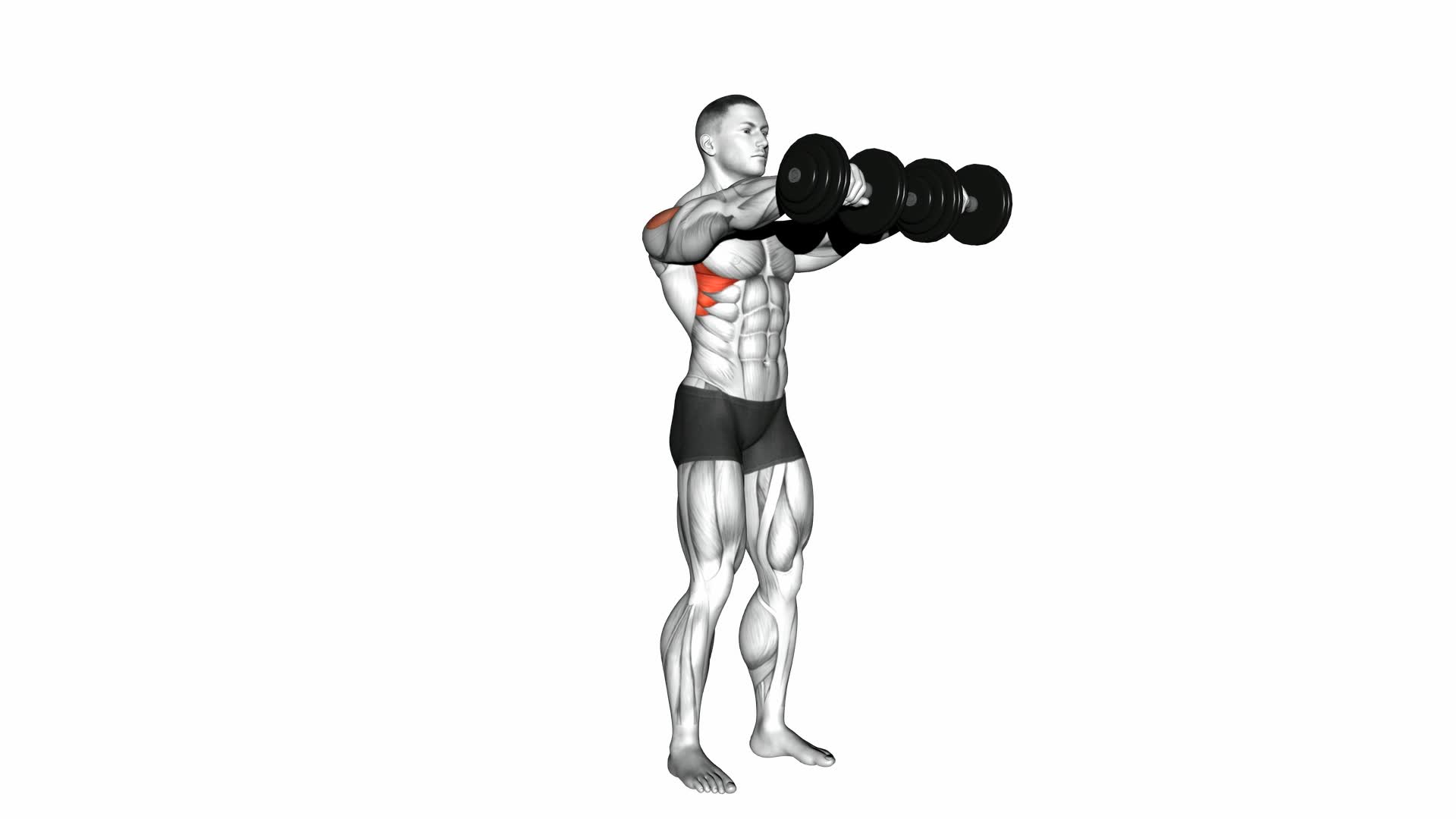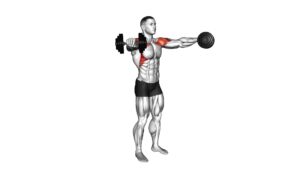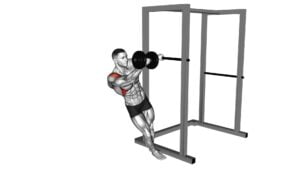Dumbbell Front Raise – Video Exercise Guide & Tips

Are you looking to strengthen and tone your shoulders?
Watch This Exercise Video
The dumbbell front raise is a great exercise to add to your routine.
In this video exercise guide, we'll show you the proper form and technique, as well as provide tips to help you choose the right weight.
Plus, we'll cover warm-up exercises, variations, modifications, and common mistakes to avoid.
Get ready to take your shoulder workout to the next level!
Key Takeaways
- Proper form and technique are important for the dumbbell front raise.
- Choosing the right weight based on fitness level is crucial for beginners.
- Warm-up exercises should be done before performing the dumbbell front raise.
- There are variations and modifications of the exercise to target muscles in different ways.
Proper Form and Technique
To perform the dumbbell front raise correctly, start by standing with your feet shoulder-width apart and holding a dumbbell in each hand. This exercise primarily targets the front deltoids, but it also engages the traps, triceps, and upper chest muscles. It offers several benefits, including improved shoulder strength, posture, and overall upper body stability.
Now, let's talk about some common errors to avoid when performing the dumbbell front raise. One mistake people often make is using excessive weight, which can lead to improper form and potential injury. It's crucial to choose a weight that allows you to maintain proper technique throughout the entire movement.
Another error is lifting the dumbbells too high, causing unnecessary strain on the shoulders. Instead, aim to raise the dumbbells until they're parallel to the ground, keeping your elbows slightly bent.
Lastly, avoid using momentum to lift the weights. This not only reduces the effectiveness of the exercise but also increases the risk of injury.
Choosing the Right Weight
When choosing the right weight for the dumbbell front raise, you should consider your current fitness level and select a weight that challenges you without compromising proper form. It's important to find a balance between pushing yourself and avoiding potential injuries.
Here are some tips to help you choose the right weight:
- Start with a lighter weight: If you're new to this exercise or have limited strength, it's best to start with a lighter weight. This allows you to focus on proper form and gradually build strength.
- Gradually increase the weight: As you become more comfortable with the exercise and your strength improves, you can progressively overload your muscles by gradually increasing the weight. This helps to stimulate muscle growth and improve overall strength.
- Listen to your body: Pay attention to how your muscles feel during the exercise. If you're able to complete the repetitions with ease, it may be time to increase the weight. On the other hand, if you're struggling to maintain proper form, it's a sign that the weight may be too heavy.
- Seek guidance if needed: If you're unsure about the right weight for you, don't hesitate to seek guidance from a fitness professional. They can provide you with personalized recommendations based on your fitness goals and abilities.
Choosing the right weight for the dumbbell front raise is crucial for both injury prevention and achieving progressive overload. By selecting a weight that challenges you without compromising proper form, you can effectively strengthen your shoulder muscles while minimizing the risk of injury.
Warm-up Exercises
After choosing the right weight for your dumbbell front raise, you can now focus on incorporating warm-up exercises to prepare your muscles for the workout. Warm-up exercises are crucial in preventing injuries and maximizing the benefits of your workout.
When you warm up before exercising, you increase blood flow to your muscles, which helps loosen them up and make them more flexible. This increased blood flow also delivers oxygen and nutrients to your muscles, allowing them to function optimally during your workout.
In addition to increasing blood flow, warm-up exercises also raise your body temperature, which helps improve muscle elasticity. This means that your muscles will be able to stretch and contract more effectively, reducing the risk of strains or tears.
A good warm-up routine typically includes dynamic stretches and movements that mimic the exercises you'll be doing during your workout. For example, before starting your dumbbell front raise, you can do arm circles, shoulder rolls, and gentle shoulder stretches.
Variations and Modifications
Now let's explore some variations and modifications you can incorporate into your dumbbell front raise routine. Here are four alternative exercises and the benefits they offer:
- Single Arm Dumbbell Front Raise: Instead of raising both dumbbells simultaneously, try raising one arm at a time. This variation allows you to focus on each arm individually, improving balance and muscle symmetry.
- Resistance Band Front Raise: If you don't have access to dumbbells, a resistance band can be a great alternative. Attach the band to a secure anchor point and hold the handles at your sides. Raise your arms in front of you, engaging your shoulders and upper body muscles.
- Plate Front Raise: Grab a weight plate instead of dumbbells. Hold the plate with both hands, palms facing down. Lift the plate in front of you, keeping your arms straight. This exercise adds an extra challenge to your shoulder muscles.
- Barbell Front Raise: If you're looking for a more advanced option, try the barbell front raise. Hold the barbell with an overhand grip, resting it on your thighs. Raise the barbell in front of you, keeping your arms straight. This exercise targets your shoulders and engages your core for stability.
Incorporating these alternative exercises into your dumbbell front raise routine can add variety and target your muscles in different ways, helping you achieve a well-rounded workout.
Common Mistakes to Avoid
To maximize the effectiveness of your dumbbell front raise, it's important to be mindful of common mistakes to avoid. By avoiding these mistakes, you can't only enhance your workout but also prevent potential injuries.
One common mistake to avoid is using too much weight. While it may be tempting to lift heavier dumbbells, using excessive weight can put unnecessary strain on your muscles and joints, increasing the risk of injury. It's crucial to choose a weight that allows you to maintain proper form throughout the exercise.
Another mistake to steer clear of is swinging the dumbbells. This often happens when people try to lift too much weight or rush through the exercise. Swinging not only reduces the effectiveness of the front raise but also puts stress on your shoulders and can lead to injury. Instead, focus on controlled and smooth movements, lifting the dumbbells in a controlled manner.
Additionally, avoid lifting the dumbbells too high. Overextending your arms can strain your shoulders and lead to discomfort or injury. Aim to lift the dumbbells to shoulder height, maintaining a slight bend in your elbows to engage the targeted muscles effectively.
Frequently Asked Questions
How Many Sets and Reps Should I Do for the Dumbbell Front Raise Exercise?
To determine the sets and reps for the dumbbell front raise exercise, you need to consider your fitness goals and current fitness level.
Start with 2-3 sets of 8-12 reps for beginners, gradually increasing as you get stronger.
Advanced lifters can do 3-4 sets of 10-15 reps.
Remember to choose a weight that challenges you without sacrificing form.
Variations of the dumbbell front raise, such as alternating arms or using a barbell, can also be incorporated for added variety and muscle engagement.
Can I Perform the Dumbbell Front Raise Exercise With a Barbell Instead?
Yes, you can perform the barbell front raise exercise instead of using dumbbells. Using a barbell for front raises offers several benefits.
It allows for a greater load to be lifted, which can help with building strength and muscle definition. Additionally, the barbell engages more muscles, including the core, to stabilize the movement.
However, be sure to start with a lighter weight and focus on proper form to avoid straining your shoulders or back.
Is It Necessary to Perform the Exercise in a Slow and Controlled Manner, or Can I Do It Quickly?
When performing the dumbbell front raise, you may wonder if it's necessary to do it slowly and controlled or if you can do it quickly.
It's important to perform this exercise in a slow and controlled manner. This allows you to focus on proper form and engage the target muscles effectively.
Doing it quickly may lead to using momentum instead of muscle strength.
Should I Perform the Dumbbell Front Raise Exercise Before or After My Main Strength Training Workout?
To maximize the benefits of the dumbbell front raise, it's important to consider the timing of your workout.
Whether you should perform this exercise before or after your main strength training session depends on your goals.
Performing the dumbbell front raise before your main workout can help warm up your shoulder muscles and activate them for the upcoming exercises.
On the other hand, doing it after your main workout can help with muscle endurance and overall shoulder development.
Choose the timing that aligns with your fitness goals.
Can I Substitute the Dumbbell Front Raise Exercise With Another Shoulder Exercise for Variety?
Yes, you can definitely substitute the dumbbell front raise exercise with another shoulder exercise for variety.
There are many benefits to incorporating a variety of shoulder exercises into your workout routine.
By doing different exercises, you can target different muscles and prevent boredom.
Some alternatives to the dumbbell front raise include shoulder presses, lateral raises, and upright rows.
Experiment with different exercises to find what works best for you and keeps your shoulder muscles engaged.
Conclusion
In conclusion, the dumbbell front raise is a great exercise for strengthening the shoulders and upper body. By maintaining proper form and technique, choosing the appropriate weight, and incorporating warm-up exercises, you can maximize the benefits of this exercise.
Additionally, variations and modifications can be used to target different muscle groups. Be mindful of common mistakes to avoid and strive for precision in your movements.
With consistency and proper execution, the dumbbell front raise can be an effective addition to your fitness routine.

Author
Years ago, the spark of my life’s passion ignited in my mind the moment I stepped into the local gym for the first time. The inaugural bead of perspiration, the initial endeavor, the very first surge of endorphins, and a sense of pride that washed over me post-workout marked the beginning of my deep-seated interest in strength sports, fitness, and sports nutrition. This very curiosity blossomed rapidly into a profound fascination, propelling me to earn a Master’s degree in Physical Education from the Academy of Physical Education in Krakow, followed by a Sports Manager diploma from the Jagiellonian University. My journey of growth led me to gain more specialized qualifications, such as being a certified personal trainer with a focus on sports dietetics, a lifeguard, and an instructor for wellness and corrective gymnastics. Theoretical knowledge paired seamlessly with practical experience, reinforcing my belief that the transformation of individuals under my guidance was also a reflection of my personal growth. This belief holds true even today. Each day, I strive to push the boundaries and explore new realms. These realms gently elevate me to greater heights. The unique combination of passion for my field and the continuous quest for growth fuels my drive to break new ground.







